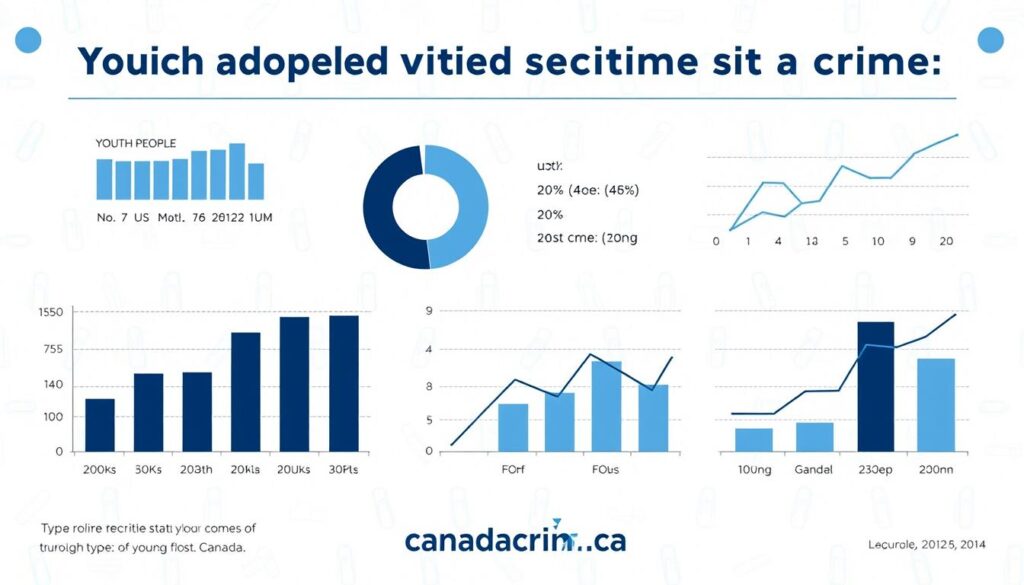Have you ever wondered how age influences criminal behavior in Canada? Understanding this connection can help shape effective prevention strategies and foster safer communities. CanadaCrime.ca, the nation’s leading source for crime statistics, provides valuable insights into these patterns.
Age demographics play a significant role in shaping crime trends. Youth and adults often exhibit different offending rates, influenced by various factors. By analyzing these trends, we can better address the root causes of criminal activity.
Socioeconomic factors also intersect with age-related crime trends, highlighting the need for targeted interventions. Whether you’re a policymaker, educator, or concerned citizen, understanding these dynamics is crucial for creating impactful solutions.
Explore how Statistics Canada data reveals the correlation between age and crime. Discover actionable insights to help reduce criminal activity across all age groups. Let’s dive deeper into the numbers and uncover what they mean for Canada’s future.
Introduction to Crime Trends in Canada
Crime trends in Canada have evolved significantly over the years, shaped by demographic and economic shifts. Since 2000, changes in population growth and urbanization have played a key role in influencing the crime rate. Understanding these patterns helps identify effective strategies for reducing offending behavior.
One notable trend is the growing youth population, particularly among Indigenous communities. By 2026, the Aboriginal youth population is projected to grow by 37%, compared to just 6% for the general population. This demographic shift highlights the need for targeted interventions in these communities.

Economic factors also play a significant role. In 2009, the unemployment rate for youth aged 15-24 reached 15%, creating challenges that often correlate with higher offending rates. Addressing these economic disparities is crucial for reducing crime among young people.
Urbanization has further impacted crime distribution. As more people move to cities, urban areas face unique challenges in managing safety and security. Meanwhile, northern territories and reserves continue to experience distinct issues, requiring tailored solutions.
Since its introduction in 2003, the Youth Criminal Justice Act has shaped how youth offenses are handled. This legislation emphasizes rehabilitation over punishment, aiming to reduce recidivism and support young offenders in reintegrating into society.
| Demographic | Projected Growth (2026) | Unemployment Rate (2009) |
|---|---|---|
| Aboriginal Youth | 37% | 15% |
| General Population | 6% | N/A |
Understanding Youth Crime in Canada
Youth crime in Canada reveals critical patterns that shape community safety. By examining these trends, we can better address the root causes and develop effective prevention strategies. Understanding the characteristics of youth offenders is key to creating impactful solutions.

Characteristics of Youth Offenders
Male youth are twice as likely to commit violent acts compared to their female counterparts. Family background also plays a significant role, with many offenders coming from unstable or low-income households. These factors highlight the need for targeted support systems.
Substance abuse is another critical factor. Studies show that 60% of youth offenders are drug users, compared to just 16% of non-users. This correlation underscores the importance of addressing addiction in prevention efforts.
Types of Crimes Committed by Youth
Property crimes, such as theft under $5,000, are the most common offences among youth. Assault and mischief follow closely, reflecting a mix of impulsive and premeditated behavior. Understanding these patterns helps tailor interventions to specific needs.
Peak crime hours for youth are typically between 3-6 PM, often occurring in homes or public spaces. These insights can guide community programs and police strategies to reduce incidents during high-risk times.
| Crime Type | Percentage of Youth Offenders |
|---|---|
| Theft Under $5,000 | 37% |
| Assault | 25% |
| Mischief | 20% |
Aboriginal youth are overrepresented in the justice system, facing unique challenges that require culturally sensitive approaches. Addressing these disparities is crucial for achieving equity in crime prevention and rehabilitation.
By focusing on these trends, we can create safer communities and support young people in making positive choices. Together, we can build a brighter future for Canada’s youth.
Crime Statistics by Age Group
Analyzing crime rates across age groups reveals key insights into behavioral patterns. By understanding these trends, we can identify where interventions are needed most. This section explores how different age brackets contribute to criminal activity and what it means for prevention efforts.

Crime Rates Among Different Age Groups
Youth aged 15-17 have the highest violent crime victimization rates, making this group a focal point for prevention. In 2010, 153,000 youth were accused of offenses, representing 6% of the 12-17 population. This highlights the need for targeted strategies to address youth-related incidents.
Teen age brackets show distinct patterns. Offending rates are higher among 15-17-year-olds compared to 12-14-year-olds. Gender disparities also exist, with males more likely to engage in violent acts. Understanding these differences helps tailor interventions effectively.
Territorial variations further complicate the picture. For example, the Northwest Territories has a Crime Severity Index (CSI) of 427, significantly higher than the national average of 90.5. These regional differences underscore the importance of localized solutions.
Violent vs. Non-Violent Crimes
Youth offenders are more likely to commit property crime than violent acts. Theft under $5,000 accounts for 37% of youth offenses, while assault makes up 25%. These trends emphasize the need for programs addressing impulsive behavior and economic pressures.
Weapon involvement is another concern. Approximately 5% of youth crimes involve knives, highlighting the potential for escalation. Sentencing trends show that 60% of youth offenders receive probation, while 15% face custodial sentences. This balance aims to rehabilitate rather than punish.
For more detailed insights into violent crime trends, explore Canada’s violent crime rate. Understanding these patterns is crucial for creating safer communities and supporting young people in making positive choices.
What Types of Crime Are Committed by Age Canada
Age plays a pivotal role in shaping criminal activity patterns in Canada. Understanding these trends helps identify where interventions are needed most. Let’s explore how offences vary across different age groups and regions.
Youth aged 12-14 are more likely to engage in minor theft and mischief. These acts often stem from impulsive behavior. In contrast, 15-19-year-olds show higher rates of property crimes and assault. This shift reflects growing exposure to peer pressure and economic challenges.
Adults aged 20+ tend to commit more serious offences, including fraud and violent acts. These patterns highlight the need for targeted prevention strategies across all age brackets.

Urban areas report higher rates of property crimes, while rural regions see more incidents of theft and vandalism. These differences underscore the importance of localized solutions tailored to community needs.
The pandemic significantly impacted youth crime rates. Lockdowns led to a 13% increase in property offences among adolescents. Cybercrime also surged, with many young people engaging in online fraud and hacking.
Federal and provincial distributions of crimes vary widely. For example, provinces with higher urban populations report more property-related incidents. Meanwhile, territories face unique challenges, such as higher rates of violent offences.
| Age Group | Common Offences | Location Trends |
|---|---|---|
| 12-14 | Theft, Mischief | Urban Areas |
| 15-19 | Property Crimes, Assault | Rural Areas |
| 20+ | Fraud, Violent Crimes | Urban Areas |
By addressing these trends, we can create safer communities for all age groups. Understanding the root causes of criminal behavior is the first step toward effective prevention.
Youth Crime on Reserves
Youth crime on reserves in Canada presents unique challenges that require targeted solutions. The crime rate on reserves is significantly higher than the national average, with 24,391 incidents reported in 2004 compared to 7,023 nationally. This disparity highlights the need for focused interventions.
Systemic factors contribute to these high rates. Limited access to education, healthcare, and economic opportunities creates an environment where youth crime thrives. Addressing these issues is essential for reducing offending behavior.

Violent offenses are 11 times higher on reserves compared to non-reserve areas. Property crimes also show a significant gap, with 41.3% of Criminal Code offenses occurring on reserves. These patterns underscore the need for tailored solutions.
Intergenerational trauma and Fetal Alcohol Spectrum Disorder (FASD) prevalence further complicate the issue. Many youth offenders come from families affected by historical injustices, perpetuating cycles of criminal behavior. Addressing these root causes is crucial for long-term change.
- Systemic barriers like poverty and limited resources.
- Higher rates of violent and property crimes.
- Intergenerational trauma and FASD prevalence.
Resource allocation for justice programs on reserves is often insufficient. Community-led intervention models, however, have shown promise. These programs focus on cultural sensitivity and local needs, offering a path toward reducing crime rates.
For example, initiatives in the northwest territories have successfully engaged youth through mentorship and skill-building programs. These efforts demonstrate the potential of community-driven solutions to create safer environments.
By addressing systemic factors and supporting local initiatives, we can reduce youth crime on reserves and build stronger communities. Together, we can create a brighter future for all Canadians.
Police-Reported Youth Crime Statistics
Understanding police-reported statistics is essential for addressing youth crime effectively. These numbers provide a clear picture of trends and help shape targeted interventions. By analyzing recent data, we can identify patterns and respond proactively.

Recent Trends in Youth Crime
In 2023, the youth crime severity index (CSI) increased by 7%, reaching 53.74. This rise highlights a resurgence in offending behavior, particularly in motor vehicle theft and fraud. Motor vehicle theft surged by 30%, while fraud cases rose by 16% between 2022 and 2023.
Provincial variations are significant. For example, Prince Edward Island saw a 100% increase in its crime rate. These recent trends underscore the need for localized strategies to address spikes in youth crime.
Impact of the Youth Criminal Justice Act
The Youth Criminal Justice Act (YCJA) emphasizes rehabilitation over punishment. Diversion programs under the YCJA have shown promising outcomes, reducing recidivism rates among young offenders. However, challenges remain in ensuring consistent implementation across provinces territories.
Police-youth community relations also play a critical role. Building trust and understanding between law enforcement and young people is vital for effective crime prevention. Programs that foster positive interactions can help bridge this gap.
| Province/Territory | 2023 CSI | Change from 2022 |
|---|---|---|
| Prince Edward Island | 65.2 | +100% |
| Ontario | 48.9 | +5% |
| Alberta | 56.7 | +10% |
| Northwest Territories | 120.4 | +15% |
By decoding the crime severity index methodology, we can better understand its implications. This tool measures both the volume and seriousness of offenses, providing a comprehensive view of crime trends. Analyzing these patterns helps policymakers and law enforcement agencies develop effective strategies.
Together, we can create safer communities by addressing the root causes of youth crime and supporting young people in making positive choices.
Social Challenges and Youth Crime
Social challenges significantly influence youth behavior, often leading to higher rates of delinquency. Factors like poverty and unstable family structures create environments where young people are more likely to engage in criminal activities. Understanding these connections is essential for developing effective prevention strategies.

Poverty and Youth Crime
Poverty is a major driver of youth delinquency. In Canada, 31% of children in single-mother households live below the poverty line. For urban First Nations children, this number rises to 57%. Economic hardship often limits access to education and opportunities, pushing young people toward criminal behavior.
Income inequality exacerbates these issues. Low-income families face higher stress levels, which can lead to increased delinquency rates. School nutrition programs have shown promise in reducing crime by addressing hunger and improving focus among students.
“Poverty doesn’t just limit opportunities; it creates environments where crime becomes a survival mechanism.”
Family Structure and Youth Crime
Family dynamics play a critical role in shaping youth behavior. Nearly half of detained youth have a history with child welfare systems. Multi-child families often experience added stress, which can contribute to delinquency. Additionally, having an incarcerated parent can create ripple effects, increasing the likelihood of criminal behavior in children.
The foster care system also impacts youth outcomes. Only 44% of foster care youth graduate high school, leaving many without the skills needed for stable employment. Addressing these systemic issues is crucial for breaking the cycle of crime.
| Factor | Impact on Youth Crime |
|---|---|
| Poverty | Higher delinquency rates in low-income households |
| Family Structure | Increased risk in unstable or multi-child families |
| Child Welfare History | 48% of detained youth have involvement |
By addressing these social challenges, we can create safer communities and support young people in making positive choices. Understanding the root causes is the first step toward meaningful change.
Prevention and Intervention Strategies
Effective strategies to reduce youth delinquency focus on prevention and intervention. By addressing root causes and providing support, communities can create safer environments for young people. Two key approaches stand out: community-based programs and early intervention efforts.
Community-Based Programs
Community-based programs have shown significant success in reducing recidivism and fostering positive behavior. For example, the Multisystemic Therapy (MST) program has achieved a 25-70% reduction in reoffending rates. These initiatives focus on mentorship, skill-building, and restorative justice.
- Mentorship initiatives connect youth with positive role models, helping them make better life choices.
- Restorative justice programs emphasize accountability and healing, reducing the likelihood of future offenses.
- Trauma-informed policing training equips officers to handle youth cases with empathy and understanding.
Early Intervention Efforts
Early intervention is crucial for addressing risk factors before they escalate. Investments in early childhood education and cross-sector partnerships have proven effective. For instance, foster care youth who graduate high school reach a rate of 81%, compared to just 44% for those in care.
Child poverty has decreased by 22% since 1996, thanks to targeted social programs. These efforts not only improve quality of life but also reduce the likelihood of delinquent behavior. By addressing systemic issues early, we can break the cycle of crime and create brighter futures for young people.
Conclusion
Understanding the relationship between demographics and criminal behavior is key to shaping safer communities. Crime statistics reveal clear patterns across age groups, highlighting the need for targeted prevention strategies. As Canada’s population evolves, addressing these trends becomes even more critical.
Investing in prevention programs can significantly reduce delinquency rates. Early interventions and community-based initiatives have shown promising results. By focusing on root causes, we can create lasting change.
Improved data collection methodologies are essential for accurate analysis. Better insights will help policymakers design effective solutions tailored to specific needs. Staying informed is the first step toward meaningful action.
For ongoing updates and detailed crime statistics, visit CanadaCrime.ca. Together, we can build a safer future for all in Canada.

